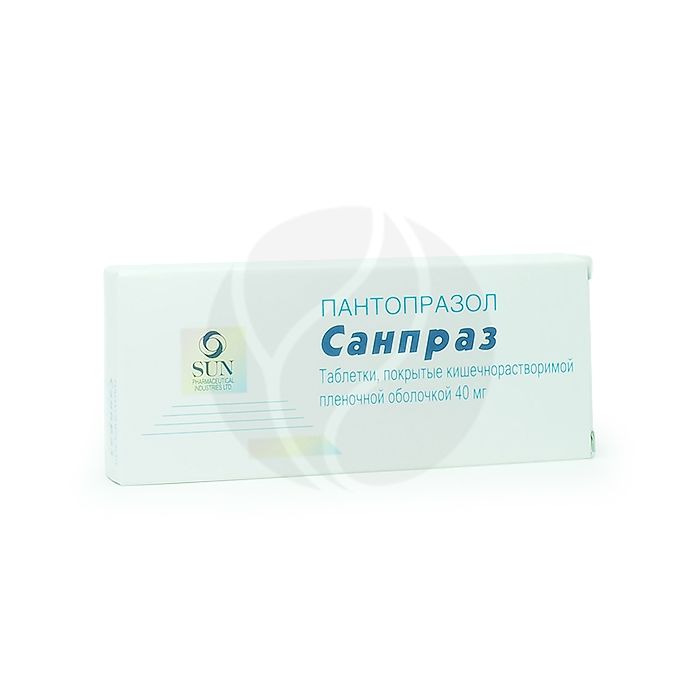Sanpraz tablets 40mg, No. 30
Expiration Date: 05/2027
Russian Pharmacy name:
Санпраз таблетки 40мг, №30
peptic ulcer of the stomach or duodenum in the acute phase;
erosive gastritis (including those associated with Helicobacter pylori);
erosive and ulcerative lesions of the stomach and duodenum associated with the intake of NSAIDs;
reflux esophagitis.
For gastric ulcer and duodenal ulcer, erosive gastritis, the drug is prescribed at 40-80 mg / day. The course of treatment for exacerbation of duodenal ulcer is 2 weeks, and gastric ulcer - 4-8 weeks.
For the prevention of exacerbations of gastric ulcer and duodenal ulcer, 20 mg / day is prescribed.
For the eradication of Helicobacter pylori, take 40 mg 2 times / day in combination with antimicrobial agents. The course of therapy is 7-14 days.
For erosive and ulcerative lesions of the stomach and duodenum associated with the intake of NSAIDs, appoint 40-80 mg / day. The course of treatment is 4-8 weeks. For the prevention of erosive lesions against the background of prolonged use of NSAIDs - 20 mg / day.
With reflux esophagitis, appoint 20-40 mg / day. The course of therapy is 4-8 weeks. For the prevention of exacerbations, take 20 mg / day.
In patients with severely impaired liver function, the dose should be reduced to 40 mg once every 2 days, while it is necessary to monitor the biochemical parameters of the blood. With an increase in the activity of liver enzymes, the drug should be canceled.
The tablets are taken orally whole (without crushing or dissolving), drinking a sufficient amount of liquid. The drug is recommended to be taken 1 hour before breakfast, with a frequency of 2 times / day the second dose - 1 hour before dinner.
Enteric-coated yellow tablets, round, biconvex.
1 tab.
pantoprazole sodium sesquihydrate 45.1 mg,?
which corresponds to the content of pantoprazole 40 mg
Excipients: magnesium oxide - 18 mg, calcium carbonate - 81.4 mg, crospovidone - 35 mg, sodium lauryl sulfate - 5 mg, calcium stearate - 3 mg, colloidal silicon dioxide - 5 mg.
dyspepsia of neurotic genesis;
malignant gastrointestinal diseases;
children's age (due to the lack of data on the use of the drug in pediatric practice);
hypersensitivity to pantoprazole.
The drug is prescribed with caution in liver failure.
pharmachologic effect
Inhibitor of H + -K + -ATPase. Blocks the final stage of secretion of hydrochloric (hydrochloric) acid, reduces the level of basal and stimulated (regardless of the type of stimulus) secretion of hydrochloric (hydrochloric) acid in the stomach. In case of duodenal ulcer disease associated with Helicobacter pylori, a decrease in gastric secretion increases the sensitivity of the microorganism to antibiotics.
Does not affect gastrointestinal motility. Secretory activity is normalized 3-4 days after the end of the drug intake.
Pharmacokinetics
Suction
After taking the drug inside, pantoprazole is rapidly absorbed from the gastrointestinal tract. Cmax is reached after 2.5 hours and is 2-3 mg / l, while the Cmax value remains unchanged after repeated administration. Bioavailability 65-77%.
Withdrawal
T1 / 2 - about 1 hour
Side effect
From the side of the central nervous system: headache; very rarely - depression, weakness, dizziness, visual impairment.
From the digestive system: diarrhea, nausea, pain in the upper abdomen, constipation, flatulence; in isolated cases (1 case per 106 patients) - severe hepatocellular liver damage with jaundice, liver dysfunction.
Allergic reactions: skin rash, itching, flushing of the skin, anaphylactic reactions (up to shock).
Others: painful tension of the mammary glands, hyperthermia.
Application during pregnancy and lactation
The drug is prescribed with caution during pregnancy and lactation (breastfeeding).
Application for violations of liver function
In patients with severely impaired liver function, the dose should be reduced to 40 mg once every 2 days, while it is necessary to monitor the biochemical parameters of the blood. With an increase in the activity of liver enzymes, the drug should be canceled.
Application in children
Contraindication: children's age (due to the lack of data on the use of the drug in pediatric practice).
special instructions
Before and after the end of therapy, endoscopic control (if necessary, with a biopsy) is required to exclude malignant neoplasms of the stomach or esophagus. the use of the drug may delay the correct diagnosis.
Overdose
Data on overdose of the drug Sanpraz are not provided.
Drug interactions
With the simultaneous use of pantoprazole can reduce the absorption of drugs, the bioavailability of which depends on the pH of the stomach (for example, ketoconazole).

